Ayon Stealth DAC and CD-T II Signature CD Transport
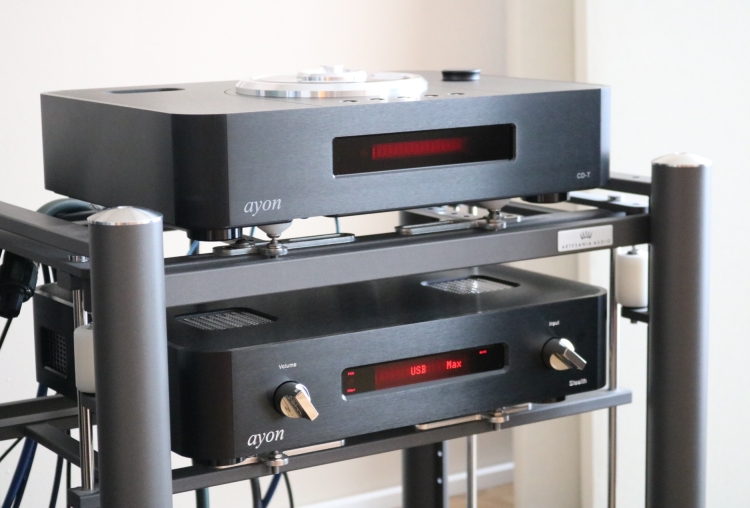
All-tube DAC/Preamp and Transport combo with a superb level of musical involvement
Review components supplied by Ayon
Retail Prices:
Stealth: 6995 euro
CD-T II: 5995 euro
CD-T II Signature (DSD output): 6990 euro
Combo offer: 12.295 euro
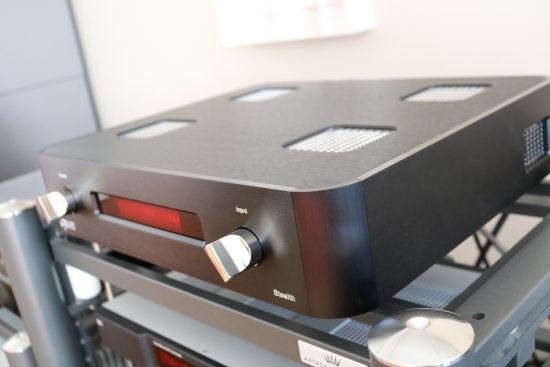
Stealth DAC/Preamp
The Stealth is a fully-fledged DAC compatible with PCM and DSD signals, converting both of these natively via a wide range of connection methods. It also has an analog preamp built-in with analog volume control and complete with two analog inputs. Importantly, the signals from these inputs remain analog throughout the DAC: they are not digitized and converted to analog again. The Stealth has a dual differential Class A output stage with two 6H30 tubes per channel. There is no negative feedback of any kind and there are no solid-state devices in the signal path: even the rectification stage is tube-based. Interestingly, the DAC employs an ESS Sabre ES9018 chipset, yet, it does not sound in any way like other DACs that use this chipset or a variant of it. In many instances, I have preferred multi-bit implementations over Delta/Sigma but there are exceptions such as the PS Audio PWD MkII and the Jeff Rowland Aeris. Evidence, once again, that the implementation tends to matter more than the components.
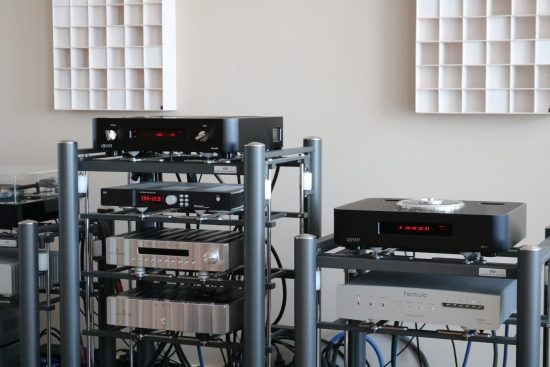
Sound
I’ve had the Ayon Sigma DAC in the system on several occasions. The Sigma is positioned as Ayon’s entry-level DAC and considering the industry trend to position serious DAC prices at the 10k mark, at 3995 euro it is priced incredibly sensibly, and even more so if you consider how great it is. Nevertheless, it took only a few audio tracks for me to strongly suspect that the Stealth has a more sonorous, more voluptuous sound than the Sigma. A cross-comparison confirmed my suspicion and also revealed an interesting detail about the filter- and upsampling options. The Sigma can sound a little dry with no upsampling but becomes smoother and more appealing with 24/192 upsampling switched on. Its bass then becomes thinner and treble more apparent but switching to Filter 2 nicely compensates for this. This way, both its owner and myself find the Sigma to sound best. Note that the manual describes filter 1 as having a slow roll-off, sounding smoother and filter 2 having a fast roll-off, sounding more analytical but in practice, I experience this in reverse. When I asked Gerhard about this, he confirmed that this is indeed stated incorrectly in the manual and has been flagged for updating in an upcoming revision.
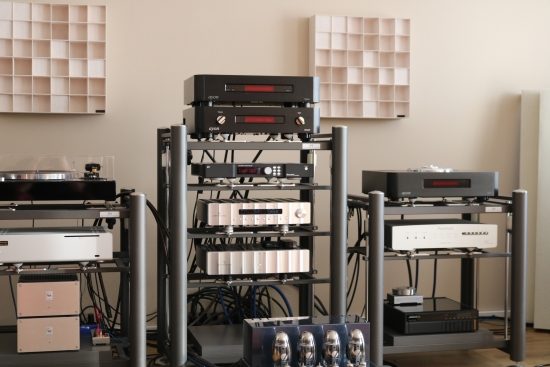
The Stealth sounds smooth, rich and seductive right from the start, even with Filter 1 and no upsampling. Filter 2 further increases the naturalness and rolls off the treble while upsampling adds a more ethereal quality to the sound which I feel is not needed for this DAC. Because I prefer its slightly tighter sound, I conducted the comparisons with Filter 1 and no upsampling. This also made for equal comparisons with the Bricasti M1 DAC and the Aqua Formula xHD DAC. The former also uses no upsampling and is generally preferred using its linear filters and the Aqua is a bespoke discrete Ladder DAC, NOS, filterless design. Different systems and taste will dictate different results, so please always just experiment with the filter- and upsampling settings to find your own preference.
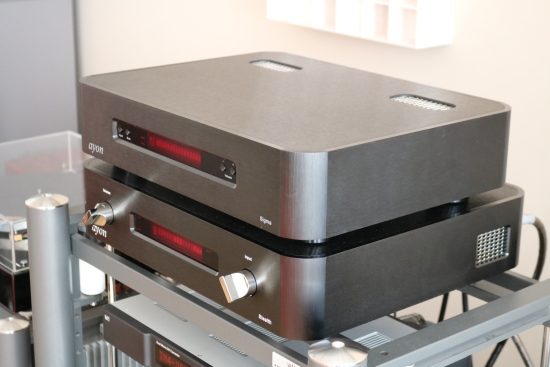
Above and below: Sigma on top of Stealth
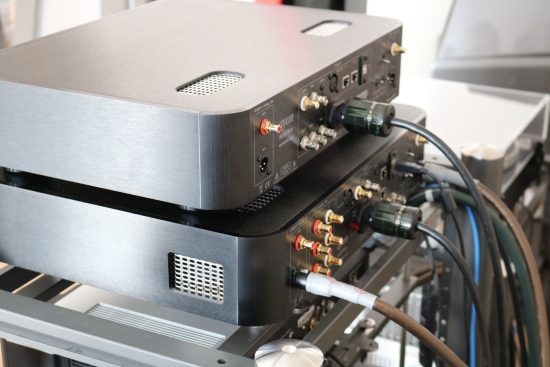
Unlike the Sigma, the Stealth has an analog preamp built-in with analog volume control and complete with two analog inputs. Importantly, the signals from these inputs remain analog throughout the DAC: they are not digitized and converted to analog again.
Before employing the Stealth as a preamp, first I wanted to assess its qualities as a standalone DAC, via the Jeff Rowland Corus + PSU preamp. The rest of the system consisted of an AudioAanZee Reference Flow music server with Euphony Drive, a PrimaLuna DiaLogue Premium power amp with KT150 tubes and recently refurbished Apogee Duetta Signature speakers as well as Wilson Watt/Puppy 8 speakers. Connection to the Stealth and all other DACs, for the purpose of this review, is always via USB, using the same AudioQuest Diamond USB cable.
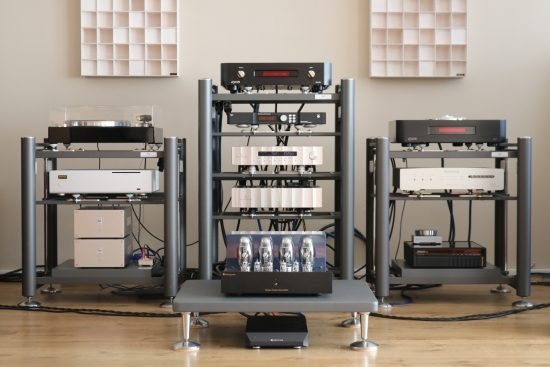
Comparisons
While not as even-handed as the 10.000 euro Bricasti or as transparent and refined as the 13.6700 euro Aqua, the Stealth DAC has a sound that appeals immediately. It sounds big and generous, with a richly colorful and free-flowing midrange and smooth, fluid, well-extended treble. There is a mild thickening in the upper bass and lower midrange that is not there with the other two DACs, which indicates that the Stealth is not entirely as transparent or as neutral as these DACs. The strange thing, however, is that technical precision is not very relevant for musical enjoyment, sometimes rather the opposite. This is definitely the case here, the Stealth drawing me into the music and not letting go until the clock tells me that it is time for bed.
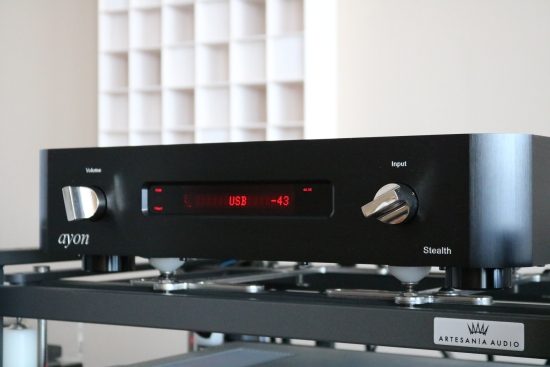
The Stealth also has two analog inputs and what better way to test them than by using the Aqua Formula xHD DAC for this. Reassuringly, several relay clicks are heard when switching to the Stealth’s analog inputs. The Aqua, connected with AudioQuest Water interlinks, indeed sounds more accurate. Compared with the Stealth’s built-in DAC, the delivery is more even-handed and detailed, with a more articulate bass. I don’t blame the Stealth though. I would say it is only fair as the Aqua Formula xHD is twice as expensive. And who knows what a 14.000 euro Ayon DAC would be capable of?
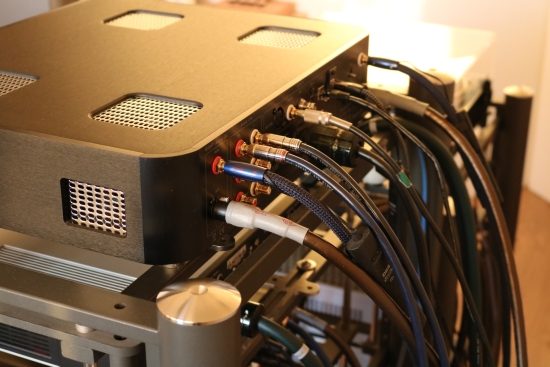
Interestingly, using its analog inputs, the aforementioned thickening in the upper bass and lower mid is still partially there and this seems to indicate that it is mostly the built-in preamp that is responsible for the unit’s character. Would the more expensive Stratos improve on this particular aspect? Perhaps it does, but ultimately this is no issue at all. Switching back to the Stealth’s built-in DAC the sound becomes less articulate and precise but also considerably smoother and richer, which definitely has its own charm, especially when used with the very revealing Wilson Watt/Puppy 8’s. As always it is the system match that defines the relative success of any audio component and the Wilsons sure love what the Stealth does.
In conclusion, while I know that tubes can actually have less coloration and distortion than solid-state equipment it is probably a conscious decision taken by Ayon to voice the Stealth the way that it is. Also, I don’t think that many tube lovers are craving absolute accuracy. Rather, these people want the music to speak to them on an emotional level. And this is exactly what the Stealth does incredibly well. Its particular character, while noticeable when switching from the aforementioned DACs, actually has a tendency to enhance the emotional acceptance of the sound once you are used to it, which is basically after a couple of tracks.
So far though, I am still using the Rowland Corus preamp. What will the Stealth do when driving the power amp directly?
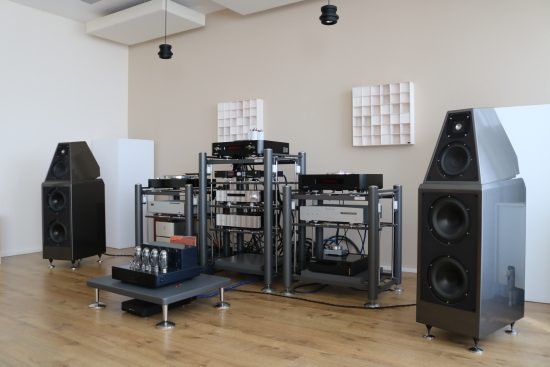
Stealth as DAC and Preamp
I will not beat around the bush: it truly amazed me how well the Stealth performed as a standalone DAC and Preamp. Up until now I had been listening to it through the Jeff Rowland Corus preamp + PSU, but when connecting it to the PrimaLuna DiaLogue Premium power amp directly, you could definitely hear how the last layer of solid-state influence dissolved, the system now sounding utterly free-flowing but every bit as powerful and energetic, arguably now even more dynamic! Up until now when removing the preamp and listening to a DAC directly usually made for better bass but always came with less appealing aspects such as a flatter soundstage or dry treble. But the Stealth is not just a DAC, of course, it is also an analog preamp!
My audio buddies JW and JC were also present during this session and they, too, were quite flabbergasted by the increase in naturalness and life-like believability. Without the Corus, a level of control, or perhaps superimposed pacing, fell away, which sometimes made me feel that the rhythm was now less evident. But how could this be? The Stealth’s preamp section was always in the signal path and adding what is basically a second preamp downstream should not make matters any better.
But the longer I listened to this setup, the more the sheer emotional content of the music simply took over from my calculating brain. Pretty soon I was completely immersed in beautiful music. In addition to the living and breathing sound, the soundstage was now also a lot deeper. It was much more like being at a live venue looking at and listening to real humans playing in different positions on a stage that extended way backward. What’s more: when focusing on PRAT and bass articulation again I noticed that there was actually nothing wrong at all, and I couldn’t understand why I felt these aspects took a step back. Apparently, I just had to get accustomed to the new, freer delivery. In any event, I was now fully enjoying all the tracks that I cared to play. As one would suspect, the fully tube-based system was fabulous with Jazz, but it was just as capable of fully conveying all the aspects of heavy R&B, Dub-Techno, and complex electronic music.
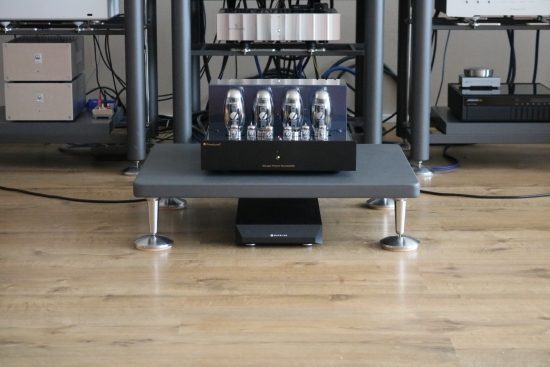
After hearing various tube power amps in my system I had already fallen out of love with the model 6 transistor power amps and I could no longer truly appreciate most of the transistor power amps that I tried after that. Surprisingly, while it can certainly be beaten by more precious designs, the very affordable PrimaLuna DiaLogue Premium power amp never fails to deliver the musical message. Substituting its EL34’s for KT150’s further strengthened the aspects that are most important to me and so it happens that the very expensive Corus preamp was partnered with the very affordable DiaLogue Premium power amp. The secret, I fear, is not in an amp’s absolute quality but in the application of tubes. For power amps, I had already made up my mind and even if I had not yet decided on a final brand, it was going to be a tube amp! But I never doubted the Corus + PSU, which is a transistor preamp, and a darn incredible one at it!
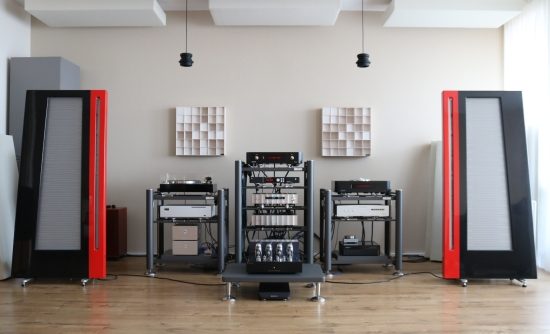
No matter which speakers are used: the Ayons always perform with verve
There is no way around it. Now having heard the level of musical involvement that is possible with the Ayon Stealth as a DAC + Preamp, I’m afraid that I am now completely spoilt for transistor designs.
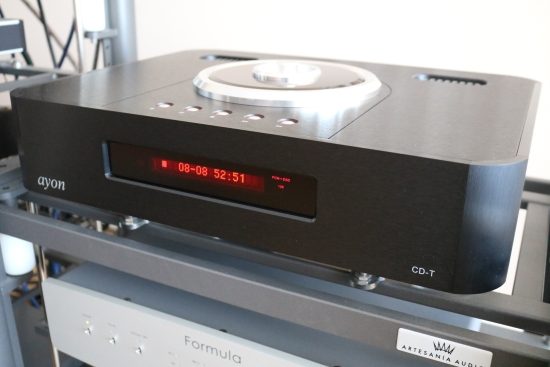
CD-T II Transport
After more than 5 years of producing the CD-T, it was decided to rework it and equip it with some special features. Like the original, the CD-T Mk II only plays Redbook CD’s but according to the maker it is designed to play these with new levels of resolution, dynamics, and musical naturalness. Ayon has kept the legendary Philips CD-Pro 2 drive, the dual digital tube buffer with 6H14, and the chassis. Special attention was paid to the new clocking system, the modified power supply, and the new dual ground system.
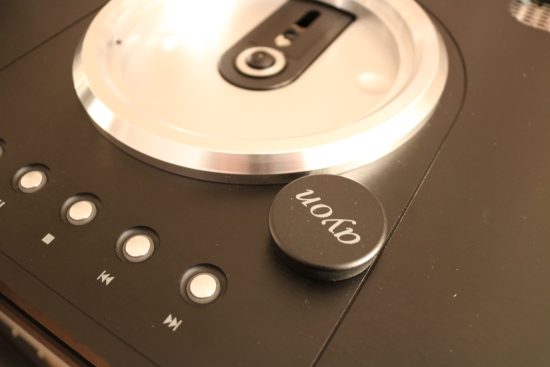
With the Signature version, there is now also the possibility to upsample CD’s to DSD 128 by means of the optionally available DSD-converter module, which is included in this review sample. The CD-clamp-system has changed from being attached to the lid to being a separate clamp that is put on manually, separate from the top lid.
I asked Gerhard why they decided to change this and he explained:
“The separate clamp is now bigger and much heavier and this stabilizes the CD much better, it is a real sound improvement. Besides this, the CD rotation noise is also less.”
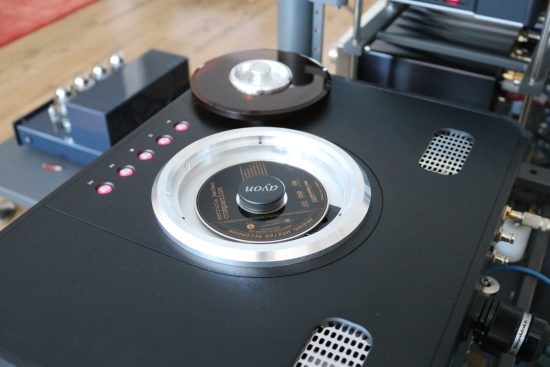
Digital outputs are now galvanically insulated from each other as well as available twice. Contrasting with the tube-only SPDIF outputs of the original CD-T (although the AES/EBU output was not tube-buffered), the CD-T II now offers separate solid-state as well as tube-buffered outputs, that can be switched between on the rear panel. The I2S output has remained and there are now also DSD L, DSD R and word clock outputs on BNC.
Sound – 16/44 SPDIF
Using the SPDIF connections, the transport outputs the native 44/16 signal. When using the I2S output, the signal is internally upsampled to 88.2kHz and this cannot be defeated on the player.
When asked, Gerhard explains:
“Over the last 12 years customers want upsampling and therefore we made it non-switchable and this makes it even better sounding instead of adding switching devices”.
When using the CD-T II transport via its I2S connection, the Stealth’s display indicates to have switched to 24/192 upsampling. Confusingly, this does not indicate that the DAC is also upsampling but the indicator is simply lit to indicate that the source signal is upsampled, in this case in the transport, and actually at 88.2. not 24/192.
I had already compared the original CD-T with two of my Levinson players (no.390S and no.37), and it has to be mentioned: the Ayon sounded better. Not smoother as one might expect given the tube association, but more dynamic and actually more involving. That was quite a surprise at the time, especially given the fact that all these players use the same Philips CD Pro2 transport, and one of the Levinsons had actually been serviced very recently during which not only the transport was replaced but also all the important capacitors.
Although I had already established that the Stealth is not only a very fine DAC but actually makes an even better DAC+Preamp, I wanted to assess the CD-T II in known circumstances so it was first listened to using my usual solid-state reference system, meaning that the Stealth DAC was left out of the picture for now. Connected from its transistor-buffered output via Belden RG59 interlink to the Aqua Formula xHD DAC which was connected to the Corus + PSU preamp, I set out to assess how the CD-T II’s SPDIF outputs compared to server replay, all in Redbook 16/44.
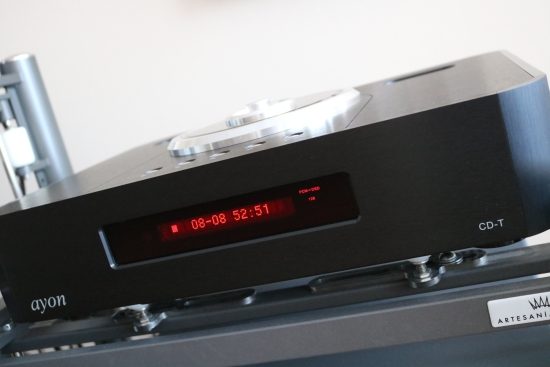
Music Server aficionados should probably look away now because I am going to write that the transport actually sounded better to me! The AudioAanZee Reference Flow music server sounds very smooth and musical and the Euphony Drive has further improved its existing qualities, but it takes literally no time at all to realize that the CD-T II simply sounds better. One might expect the transport to sound smoother or more fluid, but these are aspects where this server actually really excels. Rather, the CD-T II sounds more vivid, more dynamic and lively, and temporally also more involving. With the latter, I mean that subtle temporal changes are more apparent rather than being smoothed over. The server by comparison still sounds pleasant: just as airy, just as relaxed, and just as finely detailed, but somehow the entire experience is flattened.
When switching from the CD-T II’s transistor output to its tube-buffered output, the sound becomes even freer, perhaps less articulate, but somehow more involving still. Furthermore, the soundstage grew even deeper. Put very simply, the transistor output could be said to be more accurate but the tube output sounds more free-flowing. Personally, I lean toward the more articulate transistor output but the beauty is that there is no urgency to choose between them because the player simply offers both options, and the transport sounds superb with both outputs.
I also did a comparison with the original CD-T. Alas, the owner, dear friend “Meneer Buis” had to make do with the fact that his CD transport had now been beaten only shortly after it had beaten my Mark Levinson players. While the two were clearly made of the same cloth, the new model sounded more spritely and expressive, making the older model sound comparatively less impressive, albeit no less musical.
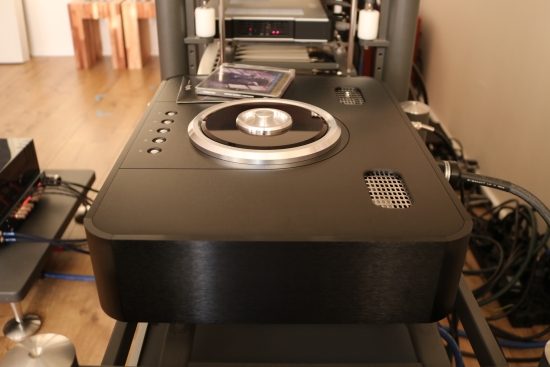
Sound – I2S and DSD upsampling
The CD-T II does more than just read CD’s: it can output them in I2S and even upsample to DSD and then output to separate DSD L, DSD R and word clock BNC connectors. When using the I2S output, the transport always upsamples to 88.2kHz. This is a good choice because it is precisely double the CD’s native 44.1kHz sample rate. If Ayon would have opted for 96 or even 192kHz then this would have meant that the upsampled values cannot be divided and always have to be averaged, which usually results in softer transients. This is why I normally prefer to leave signals in their native resolution but, alas, this setting cannot be changed. Then again: soon after I started listening to it I realized that the CD-T II sounds perfect just the way it is. Evidently, the upsampling is implemented in a very careful manner.
The Aqua DAC also decodes DSD and also offers an I2S input but because there is no real standard for this format, manufacturers tend to implement them differently, and, alas, the CD-T II’s implementation is not compatible with the Aqua’s. One could make a special ethernet cable with a bespoke pinout that should work but for the purpose of this review, I did not want to investigate this. So, here the Stealth DAC comes back into the picture. And because the Stealth had already convinced me of its preamp qualities, the Corus was left out, making the review system now 100% tube-based.
Comparing SPDIF to I2S is easily done because the transport allows connecting all its cable combinations simultaneously. I’ve often heard I2S provide a deeper soundstage than the SPDIF connections and in this case, this is also true. SPDIF offers a slightly forward sound than I2S. The bigger difference between the two formats, however, is in terms of bass. SPDIF sounds more ballsy than I2S (which I like) but I2S sounds quite a bit more precise and articulate (which I also like). I lean toward I2S but which of the two is preferred will ultimately be personal and dependent on system synergy. Fortunately, just as with the option between tube- and solid-state outputs, the choice is yours.
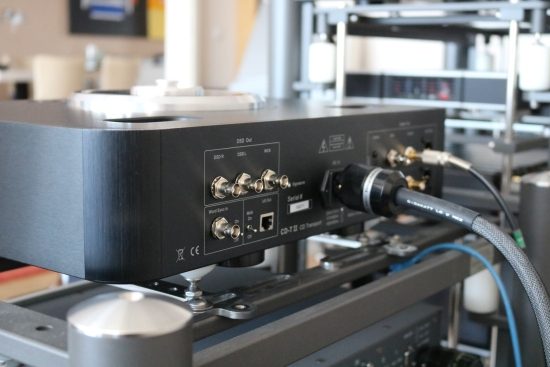
DSD upsampling seems like a good idea because Delta/Sigma DACs by nature work in a direct stream kind of way. This is one of the reasons why many modern DACs (for example the PS Audio DirectStream and the Matrix X-Sabre Pro) sound better with DSD (native or upsampled) than they do with PCM. In the case of the CD-T II and Stealth DAC however, it works out differently. When comparing I2S or SPDIF to the 3-BNC DSD inputs directly by switching between them repeatedly on the Stealth DAC, the DSD signal certainly sounds smooth and fluid, but also softer, with rounded transients, and less overall power to the delivery. Bass notes, in particular, are less weighty and less punchy. Much as I wanted to like this special DSD implementation I personally prefer the more powerful and dynamic PCM over the I2S connection.
There’s one more input option on the Stealth DAC, which is a separate “DoP” I2S input. The manual states that this input will allow DSD over PCM but that this is not yet enabled. I tried it anyway and as it turns out it currently carries the same signal as over SPDIF: upsampled 88.2kHz PCM. This connection sounds like something of a mix between the regular I2S input and the DSD inputs: more relaxed, but also less powerful than the standard I2S input.
The DSD upsampling function is a 995 euro option for the CD-T II transport. Personally, I would leave it out when purchasing it, but this is very much a relative matter. I know that there are many DSD fans out there and depending on personal taste and system matching, one might have a view different from mine. As with virtually all aspects of these two high-tech products, the choice is yours, all the options are there, for the user to freely choose from.
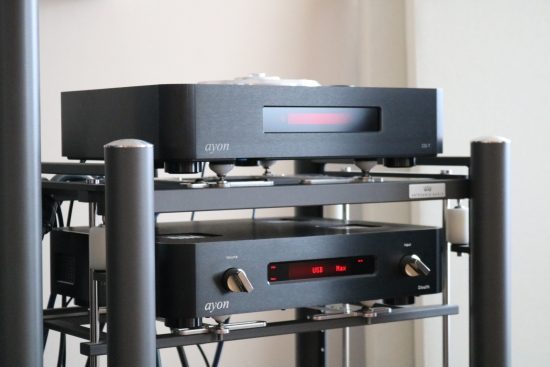
CD-T II + Stealth
I can be very brief about this… these two components combined quite simply make for the most musically involving front end that I have used in this system so far. The Stealth truly sounds great with the Music Server, better actually than any other DAC+Preamp combination used so far, but when combined with the CD-T II the two components form something of an otherworldly music machine.
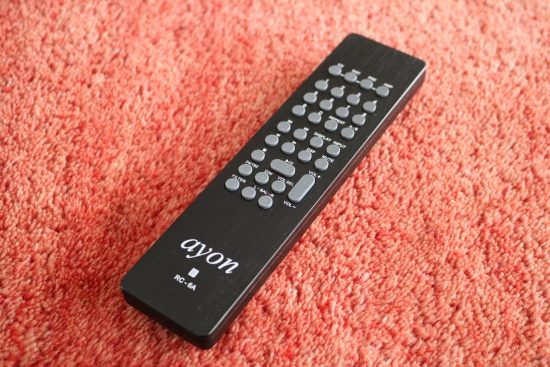
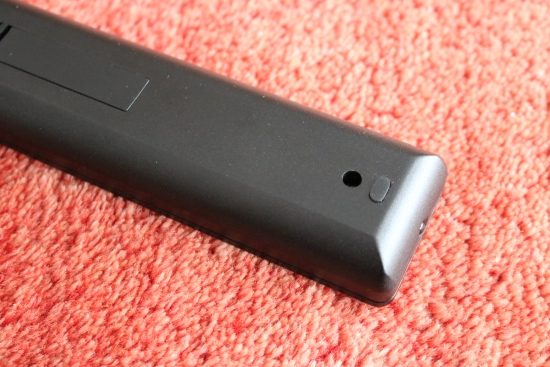
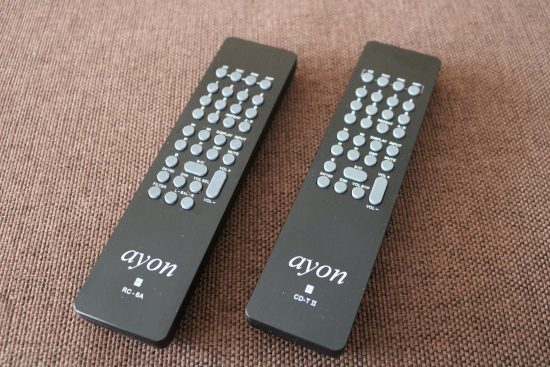
Nitpicking
These two components are clearly designed very cleverly and always with the best music replay in mind. They also offer very good ergonomics and the beautiful and rock-solid metal supplied remote controls put the plastic units of many more expensive competing products to shame. But because the Stealth DAC has so many inputs, I would have loved to see the option of choosing inputs directly, rather than only toggling through all of them in one direction. Or to have the option to disable unused inputs. The display, while excellent, is a little small, and difficult to read from my listening position, 5,5 meters from the front of the components and this makes it more challenging to find the desired input. Perhaps this functionality could be retrofitted with a new remote control? Other than this, I have nothing but praise for these spectacularly musical products.
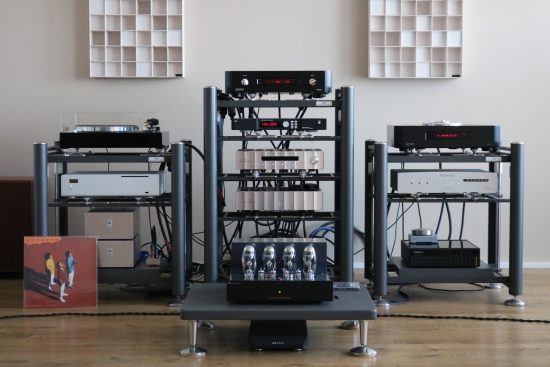
Conclusion
There is no way around it. The Ayon Stealth DAC/Preamp and CD-T II transport play with a level of musical involvement not matched by any solid-state combination that I tried so far. They make music in a way that defies the chasing of audiophile aspects. If one focuses solely on resolution, transparency, or accuracy then it is possible to find components that perform better on those aspects, but the Ayons make a very strong case for proving that this is not the point. They present music not as individual pieces of a puzzle but as a musically relevant whole. Furthermore, you’ll have to bring one heck of a Music Server to the table if you are to equal the musical flow provided by the CD-T II. This powerful, dynamic, and extremely musically involving pair has completely won me over. Highly recommended.
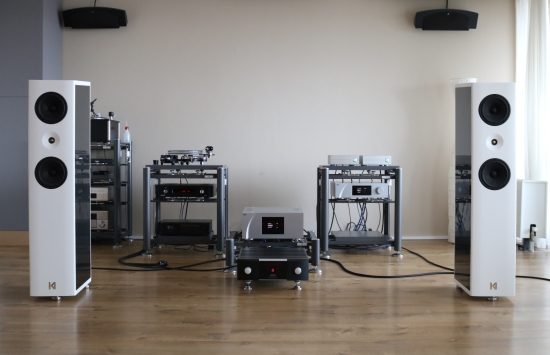
Followup comparison 13-07-2019
Upon a reader’s request, I conducted a comparison between the Stealth (as DAC and preamp) and the CH Precision C1 (as DAC with digital volume control). While highly unfair given the astronomical price difference between these two components, this is an interesting exercise nonetheless. The source for this comparison is the Antipodes CX+EX combo coupled to the respective DACs via the longest USB cable that I had at hand that is also very neutral, the KingRex uART Unanimous USB, which utilizes an OEM cable made by Wireworld. The power cables are all Belden 19364 with Bals schuko and Oyaide C-004 IECs. As interlink between the DACs and the CH Precision A1.5 power amp I used three different ones: the Cardas Clear, the Final Touch Audio Ganymede, and the Vermouth Reference, all XLR cables. The loudspeakers for this comparison are the Kroma Audio Carmens.
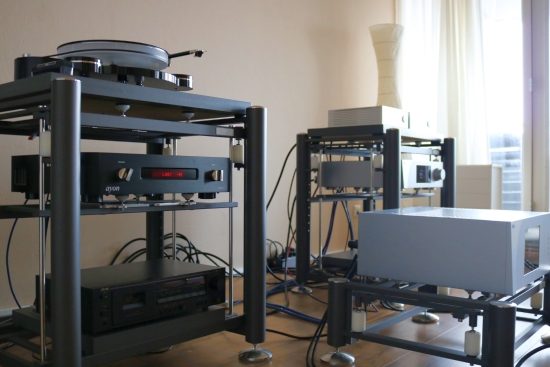
Making sure that both DACs are warmed up and set-up in the racks exactly the same and using a playlist with very different material I started my evaluations. While the C1 is a very precise sounding DAC, it is also quite sonorous and full-bodied and that’s probably why there was not much in the way of the usual difference when comparing the Stealth with pretty much any other preamp. Normally the Stealth is easily the most robust and colorful but in this case, on these parameters, I’d say it was a match. That’s still pretty amazing given that the stealth costs so much less and is tube-based.
I should note that the Kroma’s are themselves quite characterful and full-bodied and so they don’t require any added richness from connected components which also makes the C1 a better match.
Where the Stealth also performs admirably is in the size and lushness of the soundstage. While I can’t say that it was any more focused or larger per se than that of the C1’s, I also can’t say that the C1 was better in this area and the Stealth certainly imaged well outside of the speakers.
Where the two components really do differ from one another is in terms of speed, bass articulation, overall precision and transparency where the C1 comfortably takes the lead. And, honestly, that is to be expected when removing a line stage from the signal path as well as taking on an absolute reference-class DAC. The Stealth sounds less crispy and clear, more covered-up/filtered and also more relaxed, a little slower, by comparison. I quite like my music to be fast-paced and very articulate but I know that many people prefer a gentler approach and the Stealth provides this but while retaining a great sense of dynamics and a large portion of the C1’s slam. The C1 does sound considerably drier, again the result of deleting the line stage from the signal path. This certainly adds to the sense of bass articulation and overall precision but this is also not everyone’s cup of tea. Importantly, while my brain was signaling me that I was missing some precision and transparency, the music was definitely very involving, as also evidenced by the rhythmically tapping of my foot.
Of the three interlinks, the Stealth performed arguably best with the Vermouth Reference for this cable made it provide the most articulate bass and the best clarity overall. The Cardas was also very nice but a little softer and gentler while adding a touch more low-level resolution. The Ganymede, finally, made for the airiest and subtle sound with an absolutely mesmerizingly free-flowing delivery at the cost of some bass precision and slam.
A precision machine the Stealth may not be but it certainly delivers the soul of the music along with big, bold, bass, a rich and colorful presentation, and impressive dynamics.

More Ayon
Ayon CD-T CD transport (mini review)
Ayon Spirit III
Ayon Sigma DAC
Ayon Orbis preamp (mini review)
Ayon Scorpio and S3-Junior
Ayon S10-II Signature
External Links
Manufacturer: Ayon Audio
Distributor for the Benelux: Mafico






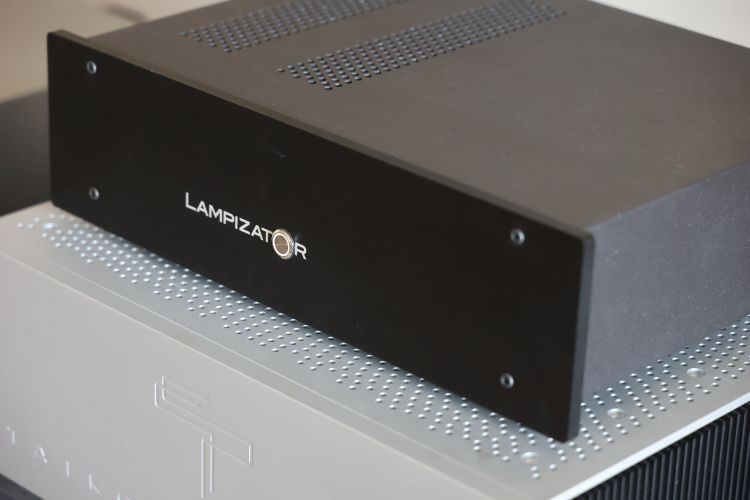
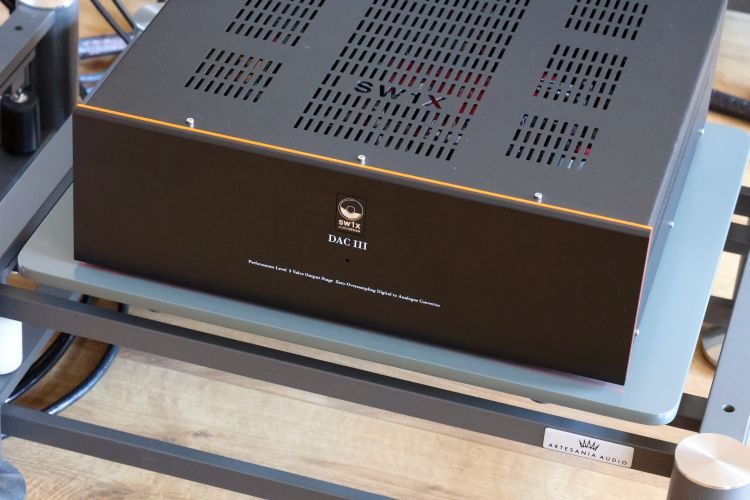
Was wondering if you’ve ever compared the Ayon front end to the PS Audio’s DMP transport and DSD SR. dac?
I have an Ayon 07s, and just purchased the PS Audio DMP and DSD dac, which I’m running directly into my amp, as I did with the 07s. Yes the PS Audio gear surpasses the Ayon player in many areas, except one very important area, tonality. I think if a had a good tube preamp the PS Audio gear would benefit greatly, and would add the missing bloom and tonality I’m missing, but now I’m thinking of just getting the Ayon cd 35, which has a built-in tube preamp, especially since I really enjoyed the 07s so much.
Thanks
Hi Gary, I’ve not directly compared these brands and while I don’t find PS Audio to sound cool or clean, I understand what you’re saying about tonality. The Ayon gear really is wonderfully full-bodied and rich of tone. I haven’t yet heard the 35 CD player but have a feeling that it might be great.
Greetings Christiaan. Did you ever compared the psaudio DSD dac and the ayon stealth? I know the last one has the internal preamp, but I was imagining the psaudio would have a much higher resolution… am I correct?
Thanks
Hi David, I’ve not had the Stealth and DS DAC side by side but I need no comparison to know that the PS Audio indeed has much higher resolution. In that regard, it ranks along with the top DACs. The Stealth does counter with considerably more solid and powerful bass and bolder, more saturated, mids. Do note that I’m only commenting on the Stealth using PCM but it also does DSD.
I came to this review because I am not totally satisfied with the DS (modded Oppo 203 – DS – ATC & JL Audio sub actives). I don’t find it cool or lean either, but it is a bit cooler (a little less engaging) than I like. I find myself listening more to the “sonic effects,” as someone put it, rather than to the music itself more often than I would like. What I’m not clear about is what in your view “much higher resolution” – please define what’s included – means relative to the Stealth’s “more solid” bass and “more saturated mids” and other qualities. Since the cost of entry to a Stealth is not low (audition at a distance and lack of used market for Ayon in the US), what I’m trying to get a better sense of is what I might be gaining and losing with a Stealth.
I would also suggest that you re-review or update the review with the latest DS firmware, Snowmass (that is, the first version – 3.01, which most have found more open than the final 3.05, or the new 3.06 when it comes out momentarily), because by lowering the noise floor substantially, it may speak to at least your bass reservations.
Hi Gene, the DirectStream DAC ranks among those that have “retina-like” resolution. By that, I mean that they are so finely resolving that there is no edge, square-ness, roughness or anything of the sort, especially noticeable as a highly fluid and refined treble but also evident from extra fine texturing and the reveal of the subtlest low-level details. In these aspects, the Stealth performs less well than the DS. The Stealth counters with a much more solid, powerful, and sonorous bass and it is richer and more colorful in the midbass and midrange. Both DACs are very “musical”, neither is either too technical or too mellow. I’d say it is between powerful bass and rich tonality versus super high resolution and airiness. But which of these two deliveries translates to a better sound for you, is a relative matter and a very personal one at that.
Thanks for your reply. I guess the key or question for me about taking the chance is how much less resolving the Stealth is. Btw, what exactly do you mean by “more solid, more powerful?”
For the DS, I and many others have found that the Snowmass firmware lowered the noise floor (and whatever else) so much that the low end comes out more, at least absolutely speaking, including for people with subs.
Thanks, Christopher! One question: In the third to last paragraph, which does the foot tapping last sentence refer to?
The obstacle with high end tube products these days in the States, and I hear in at least GB as well, is that there isn’t much of a second-hand market. So the buyer better be ready to be satisfied with something like the Stealth for the long haul.
Btw, have you tried the MG Audio Design ICs (AG2S2), or interlinks as they are called over your way? Not sure if they are sold in Europe, but they are the favorites of Paul McGowan and used in PS Audio’s main listening room with the IRS and at shows.
I have further clarified that paragraph. Foot-tapping is a sign of a good rhythmical aspect and involvement with the music. This is something that can stand apart from technical and audiophile aspects. MG Audio Design I’ve not yet come across.
Hi Christiaan,
I’ve come across an ex-demo Ayon Stealth preamp DAC for sale. I’m wondering whether this represents a good step on from my Master 1 & R8 DAC.
Could you also guide me on whether this would represent good synergy with my pair of Nuprime AMG-STA amps & Wilson Benesch P1.0s please?
Best wishes,
Jason
Best wishes,
Jason
Hi Jason, I’ve used the Stealth with the NuPrime ST-10 for quite some time in the secondary setup with the Xavian Perlas and really loved the combo! Even friends who are known to be opposed to Class-D now commented on how infectious the music sounded, especially when playing LPs. As you may know, I have reviewed the P1.0’s in the same system and liked them a lot. But whether the Stealth is a step up on the M1 and R8? That’s a tough one. They’re just too different to be classified like that. Basically, the AGD combo maximizes transparency, openness, articulation, detail, focus, etc while the Stealth maximizes robust solidity, tonal saturation, dynamic slam and impact, harmonics, etc. I’m afraid only you can decide. Are you looking for bigger bass, more impact, deeper tonal saturation, and a slightly darker sound? The only thing I can add is that the ST-10 and Stealth are both very rock ‘n roll and a little rough but the AMG-STA is super refined and fluid and it might offset the balance in just the right way for someone coming from an AGD system.
Hi Christiaan,
Thank you for your typically considered reply!
I’ve been focussed on a power upgrade for sometime. Switching over from UK to schuko plugs, Belden cable & Oyaide connectors with a Vibex power distributor & a furutech rhodium UK wall socket. This is an upgrade still in progress…
So, I was distracted by seeing this Ayon Stealth for a good price. 🙂
I’m very happy with the AGD components, if still a bit miffed that trying a Benchmark DAC recently resulted in marginally more detailed, richly textured vocals. Such an intoxicating marginal improvement though!
No probs, Jason. Well, I’ll admit that the AGD components are not the richest-sounding, actually a little bit on the analytical side. Given your preference for the Benchmark’s more richly textured vocals, you might be in for a pleasant surprise with the Stealth:-) Just make sure that the tubes have not passed beyond their use-by-date. In case of doubt, just get some new ones, I think they shouldn’t be very expensive.
So I’ll be sure to try the Ayon Stealth in my system before buying!
Best wishes,
Jason
Hi Christiaan,
So it seems we’ve exchanged messages about Ayon gear before! lol…
I bought a secondhand Ayon Stealth tonight rather that a Spirit III, so that I can hold on to my pair of AMG-STAs.
I’ll be able to reuse my Foilflex XLR cables as interconnects between Stealth & STAs, at least until I can try some others. Is there anything else I need to think about when connecting the Stealth to the AMG-STAs?
I’ll also be able to reuse my Cardas digital XLR, to connect from my streamer to the Stealth.
Thanks again in advance for your guidance. I get such satisfaction from following your example! Except in this case, re-reading your articles, it doesn’t seem as if you wrote about trying out the Stealth with a pair of AMG-STAs &/or the WB P1.0s.
Best wishes,
Jason
Hi Jason, ha yes, apparently so! Nice to hear you are taking the Stealth + AMG-STA route. I am confident that this will make a great pairing. Use it in Direct Amp mode. I used low gain but YMMV.
I have obtained super-rhythmic and highly involving results when combining the Stealth with the ST-10 and I still think it is a very nice preamp, especially if you can also use its DAC section. As it was in use for my main phono section prior to the L1, I was not eager to disconnect it for experiments in the other room. However, recent experiences have been illustrative in terms of what’s possible with an analog preamp. The main areas in which the Stealth could do better are transparency and resolution which is normally no problem since it compensates with its huge drive and musicality but for me, as a main preamp in my main system, it is not clean enough, which is why I used the AGD Master 1 and now the CH L1. But don’t let that spoil anything for you. I’m sure that you will have lots of lot of fun with your combo!
I’m having lots of fun on day one listening to my system with the Stealth as preamp & DAC! 😀 I don’t have a remote, so I seem to be restricted on the settings I can change. I’ve contacted my local Ayon dealer to order one.
I do love this richer tonal character right now & I also recognise the loss of some transparency. For me it sounds like a good trade so-far.
I’ll let you know how I go further in, when I have a manual & remote to guide me to trying the other settings you covered in your review.
So far, so very good for another of your recommendations Christiaan! 🙏
Hi Jason, Nice, glad to hear you are enjoying the Stealth!
Hi Christiaan,
I trust you’re well. Just a short update: I returned the Stealth I sourced as it didn’t come with a remote & that’s an expensive accessory as it turns out.
I’ve now spent a couple of weeks with a used Stratos I sourced from Germany.
I’m a very happy high end audio enthusiast! My system sounds so much more grown-up to me… I love the richer, darker tone & fuller, more articulate bass. There’s also a lot of subtlety in the way micro-details are presented. Obviously I’m enjoying listening to music even more as a result. The best of times to be had! 🙂
Best wishes,
Jason
Hi Jason, Ah, the Stratos, that’s even better:-) Glad you like it!
Hi Christiaan,
I trust you’re well. I’ve been enjoying my Stratos DAC immensely!
From what I can tell re-reading your article it has the same options as the CD-35 when it comes to I2S. I’d like to take advantage of this input to playback DSD content but it is incompatible with my current streamer’s HDMI I2S output.
I’m also investigating how best to add local storage to my system too, so I found my way back to your article!
The thing is, I can’t quite figure out which streaming/local storage device you were connecting to the CD-35/Stealth, via I2S & who the manufacturer of the cable you used is.
I’m probably being dim, but could you give me the benefit of your experience here please? At this point I would be prepared to change my streamer over the Stratos of course.
I have been doing some experimenting using Audivarna & my Macbook this afternoon and the extra resolution available, even while relying on USB is very exciting!
Best wishes,
Jason
Hi Jason, the server during the review was an AudioAanZee Reference Flow with USB output. It’s the silver unit on the left underneath the turntable.
I2S is often the best option, provided that the cable is kept short and the implementation of both interface ends is done well. Also, some interfaces may be off-the-shelf modules, some of which convert internally to S/PDIF. Others output to USB which can work well but may not. The bottom line is it depends, just as with USB. You just have to try it to find out:-).